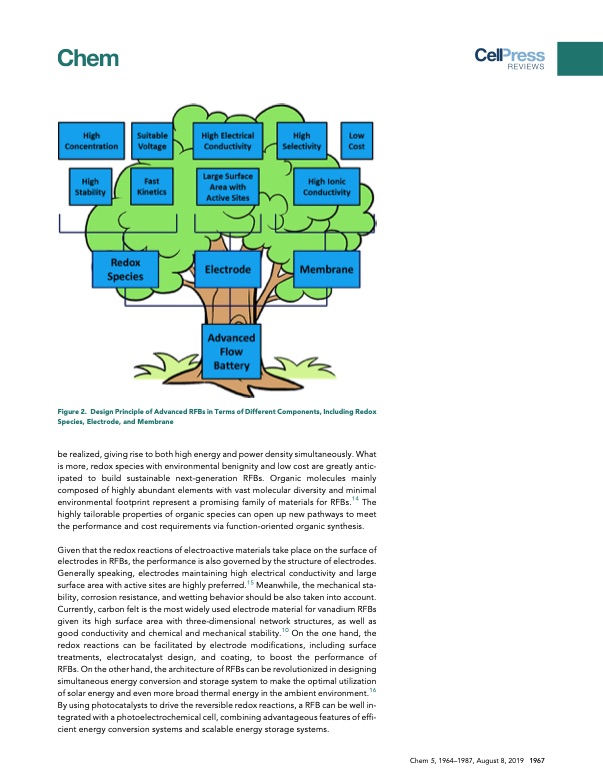
PDF Publication Title:
Text from PDF Page: 004
Figure2. DesignPrincipleofAdvancedRFBsinTermsofDifferentComponents,IncludingRedox Species, Electrode, and Membrane be realized, giving rise to both high energy and power density simultaneously. What is more, redox species with environmental benignity and low cost are greatly antic- ipated to build sustainable next-generation RFBs. Organic molecules mainly composed of highly abundant elements with vast molecular diversity and minimal environmental footprint represent a promising family of materials for RFBs.14 The highly tailorable properties of organic species can open up new pathways to meet the performance and cost requirements via function-oriented organic synthesis. Given that the redox reactions of electroactive materials take place on the surface of electrodes in RFBs, the performance is also governed by the structure of electrodes. Generally speaking, electrodes maintaining high electrical conductivity and large surface area with active sites are highly preferred.15 Meanwhile, the mechanical sta- bility, corrosion resistance, and wetting behavior should be also taken into account. Currently, carbon felt is the most widely used electrode material for vanadium RFBs given its high surface area with three-dimensional network structures, as well as good conductivity and chemical and mechanical stability.10 On the one hand, the redox reactions can be facilitated by electrode modifications, including surface treatments, electrocatalyst design, and coating, to boost the performance of RFBs. On the other hand, the architecture of RFBs can be revolutionized in designing simultaneous energy conversion and storage system to make the optimal utilization of solar energy and even more broad thermal energy in the ambient environment.16 By using photocatalysts to drive the reversible redox reactions, a RFB can be well in- tegrated with a photoelectrochemical cell, combining advantageous features of effi- cient energy conversion systems and scalable energy storage systems. Chem 5, 1964–1987, August 8, 2019 1967PDF Image | Development of Redox Flow Batteries Based on New Chemistries

PDF Search Title:
Development of Redox Flow Batteries Based on New ChemistriesOriginal File Name Searched:
PIIS2451929419302207.pdfDIY PDF Search: Google It | Yahoo | Bing
Salgenx Redox Flow Battery Technology: Salt water flow battery technology with low cost and great energy density that can be used for power storage and thermal storage. Let us de-risk your production using our license. Our aqueous flow battery is less cost than Tesla Megapack and available faster. Redox flow battery. No membrane needed like with Vanadium, or Bromine. Salgenx flow battery
| CONTACT TEL: 608-238-6001 Email: greg@salgenx.com | RSS | AMP |